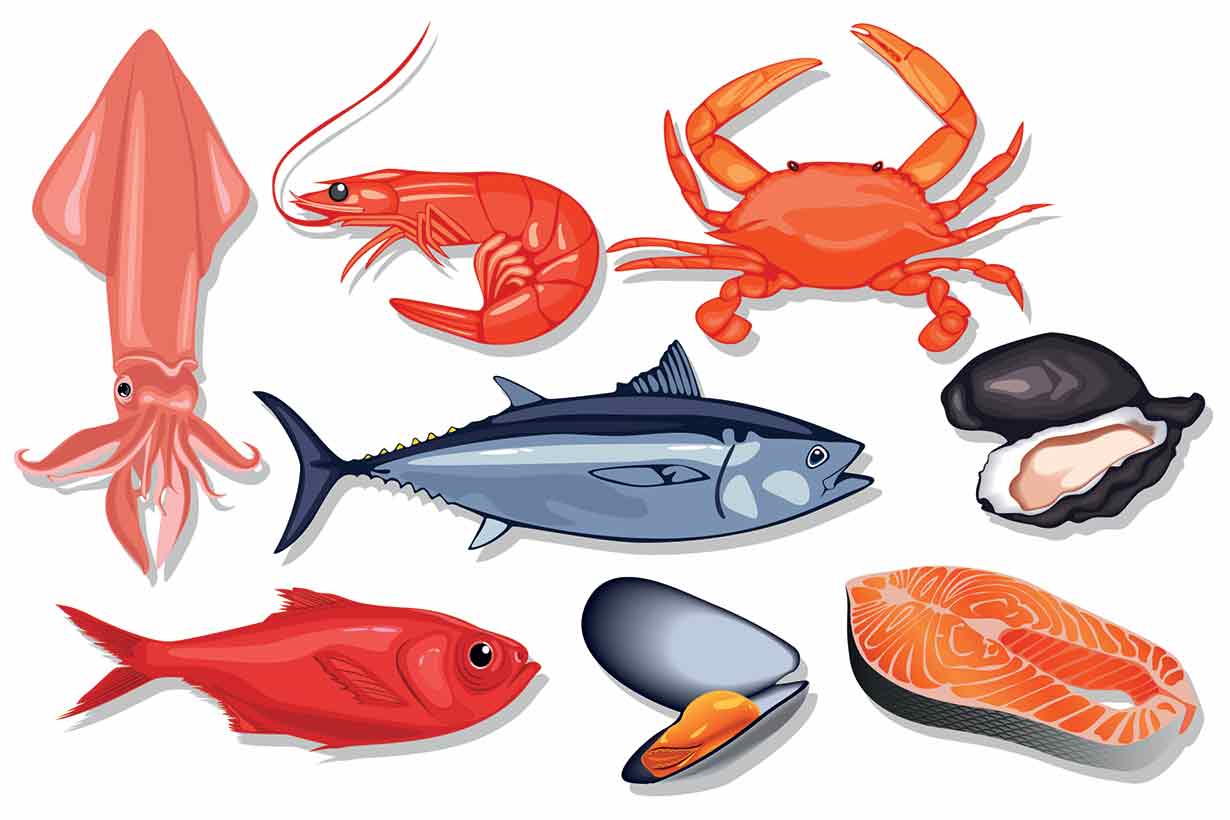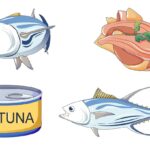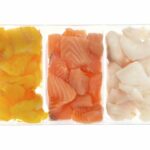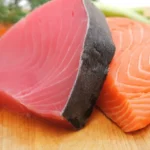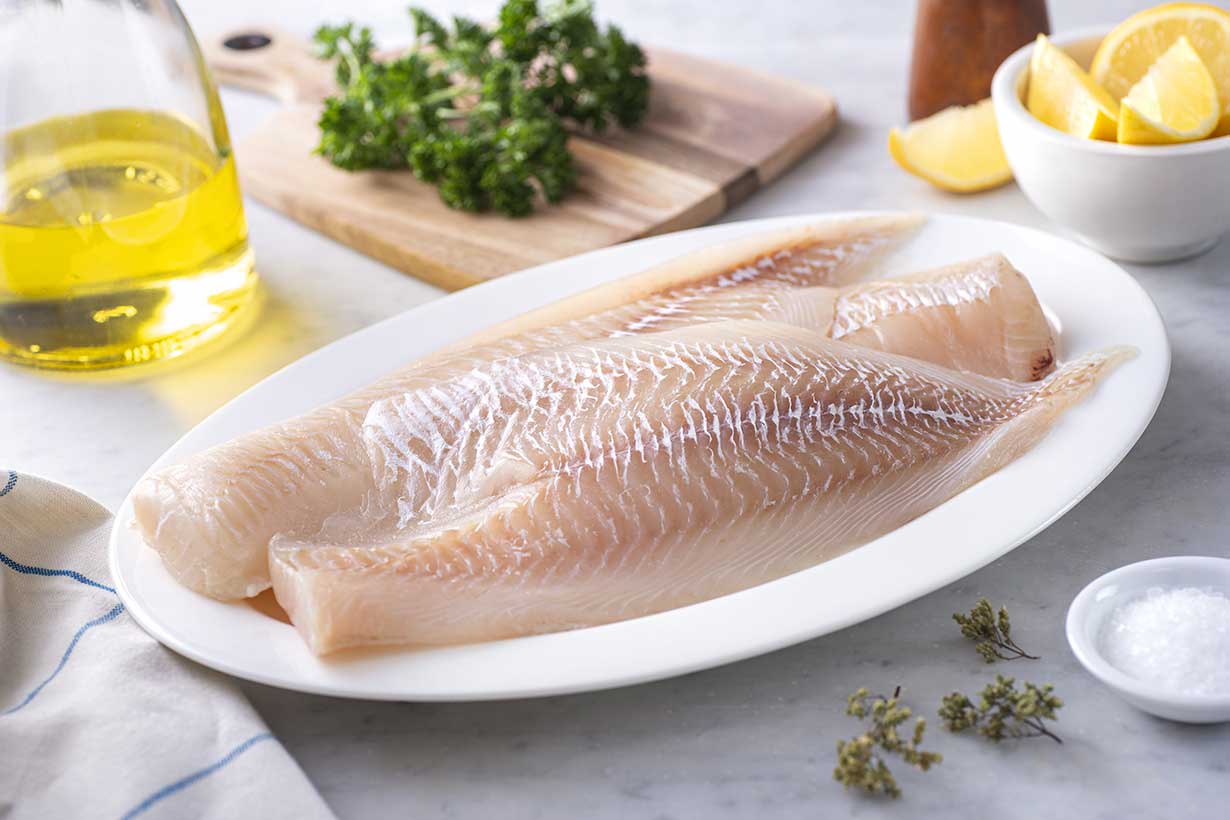Most seafood provides a rich range of beneficial nutrients, but it can be relatively expensive.
However, canned fish is comparatively very affordable, just as nutritious, and very convenient.
This article presents 16 of the most common types of canned fish and shellfish alongside the typical nutritional values per can for each one. These nutritional values are based on fish canned in water.
Since mercury contamination is a typical concern with seafood, the mean mercury content of each fish will also be provided. The source of this mercury data is a twenty-two-year monitoring program of mercury levels in commercial fish by the US Food and Drug Administration (FDA) (2).
Recommended servings per week based on joint advice from the FDA and Environmental Protection Agency (EPA) are also provided (3).
For reference, the EPA considers one serving to be four ounces (113g).
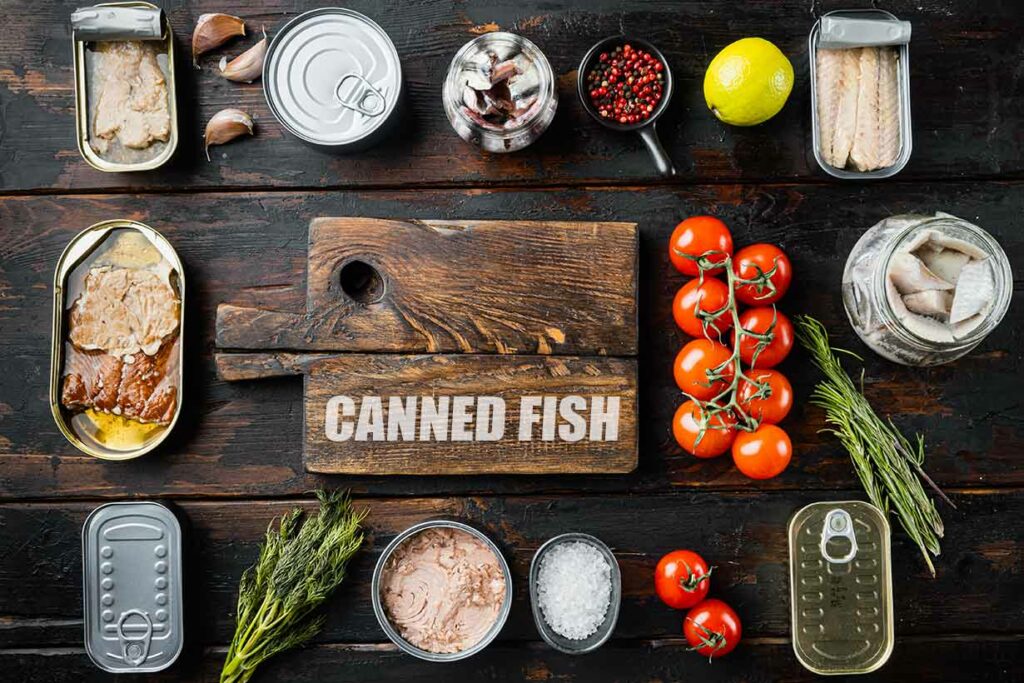
Table of contents
1. Canned Albacore Tuna
Also known as ‘white tuna’ and ‘longfin tuna,’ albacore has a mild flavor and a light white-ish texture resembling chicken breast.
This variety of tuna tends to be a good source of omega-3, but it also has one of the highest mercury contents among canned fish.
Additionally, it is more expensive than the cheaper varieties of tuna, such as skipjack.
According to the NCC nutrition database, here are the basic nutrition facts for canned albacore tuna per 5 oz can (129g drained) (1):
- Calories: 170 kcal
- Carbohydrate: 0 g
- Fat: 3.83 g
- Protein: 30.47 g
- Omega-3 content: 1.29 grams
Mercury Content
Based on 451 samples, canned albacore tuna had a mean mercury concentration of 0.350 parts per million (PPM) (2).
Advice from the FDA and the EPA recommends no more than one serving of canned albacore tuna per week (3).
2. Canned Anchovies
Anchovies are one of the smallest varieties of commercial fish.
Although they look like sardines, they are from a different (Engraulidae) family of fish.
Canned anchovies are very versatile, and people can consume them in many different ways.
Among the most popular ways of consuming them, anchovies may be eaten alone, on toast, in pasta dishes, on pizza, for salads, and in stews.
According to the USDA’s FoodData Central database, a 2-oz (45g drained) can of anchovies provides (4):
- Calories: 94.5 kcal
- Carbohydrate: 0.0 g
- Fat: 4.37 g
- Protein: 13.0 g
- Omega-3 content: 0.99 grams
Mercury Content
From a total of 15 samples, canned anchovies had a mean mercury concentration of 0.016 parts per million (PPM) (2).
Due to their low mercury content, the EPA’s recommendations allow three servings per week of canned anchovies (3).
3. Canned Crab Meat
Crab is one of the most popular shellfish, but it can be pretty expensive.
On the positive side, canned crab meat is much more affordable and contains the same nutrients.
Based on USDA FoodData Central database data, one 6.5 oz (125g drained) can of crab meat supplies (5).
- Calories: 104 kcal
- Carbohydrate: 0.0 g
- Fat: 0.93 g
- Protein: 22.4 g
- Omega-3 content: 0.24 grams
Mercury Content
From 93 samples, crab had a mean mercury concentration of 0.065 parts per million (PPM) (2).
Based on the mercury content of crab, the EPA recommendations allow for three weekly servings (3).
4. Canned Herring
Herring is a common and popular form of oily fish.
However, the canned form tends to be more widely available than fresh herring.
Once again, herring from a can is just as nutritious as the fresh fish.
According to the NCC nutrition database, a 136-gram can of herring offers (1):
- Calories: 295 kcal
- Carbohydrate: 0.0 g
- Fat: 16.82 g
- Protein: 33.43 g
- Omega-3 content: 3.61 grams
Mercury Content
The FDA’s mercury monitoring program found that, from 27 samples of herring, the mean mercury concentration was 0.078 PPM (2).
Since it contains so little mercury, the EPA recommendations allow three weekly servings of canned herring (3).
5. Canned Kippers
The only difference between herring and kippers is that the latter are smoked herring made traditionally.
As a result, kippers share many of the same nutritional traits as herring, aside from having a slightly higher salt content.
According to the NCC nutrition database, a 136-gram can of kippers has the same values as canned herring (1):
- Calories: 295 kcal
- Carbohydrate: 0.0 g
- Fat: 16.82 g
- Protein: 33.43 g
- Omega-3 content: 3.61 grams
Mercury Content
Since kippers are smoked herring, the mean mercury concentration is the same as herring at 0.078 PPM (2).
EPA recommendations allow for three weekly servings of herring, so the same will be valid for kippers (3).
6. Canned Mackerel
Mackerel belongs to the same family of fish (Clupeidae) as sardines and herring (6).
Like those other fish, and as an oily fish, canned mackerel is a significant source of omega-3.
While mackerel isn’t among the most expensive seafood varieties, canned mackerel is even cheaper and more widely available, making it convenient.
The USDA’s FoodData Central entry for canned mackerel shows it offers the following profile per 3 oz (85g) serving (7).
- Calories: 133 kcal
- Carbohydrate: 0.0 g
- Fat: 5.36 g
- Protein: 19.7 g
- Omega-3 content: 1.17 grams
Mercury Content
Most canned mackerel is made with Atlantic mackerel, which is a low-mercury fish. Based on 80 samples, Atlantic mackerel had a mean mercury concentration of 0.05 PPM (2).
According to EPA-FDA fish advice, it is OK to consume three weekly servings of canned Atlantic mackerel (3).
7. Canned Mussels
Mussels are among the most nutrient-dense of all foods, and they provide a wealth of vitamins and minerals.
However, finding fresh mussels can sometimes be challenging (and they are much more expensive).
Canned mussels are generally easy to find, and they are a more widely-available form of this popular shellfish.
According to the USDA FoodData Central database, a 122-gram can of mussels provides (8):
- Calories: 120 kcal
- Carbohydrate: 5.0 g
- Fat: 3.0 g
- Protein: 17.0 g
Mercury Content
The FDA and EPA data does not have a listing for the mercury content of mussels.
However, all types of mussels are very low in mercury (9).
8. Canned Oysters
As a fellow member of the mollusk family of shellfish, oysters are similar to mussels nutritionally.
However, oysters are arguably even more nutritious.
Similar to mussels, canned oysters are far cheaper and more widely available than fresh oysters.
According to the USDA’s FoodData Central database, a 3-oz (85g) can of oysters provides (10).
- Calories: 58 kcal
- Carbohydrate: 3.32 g
- Fat: 2.1 g
- Protein: 6.0 g
- Omega-3 content: 0.45 grams
Mercury Content
Based on FDA data, oysters have one of the very lowest mercury concentrations among all seafood. Based on 61 samples, the mean mercury concentration of oysters was only 0.012 PPM (2).
According to EPA-FDA fish advice, it is fine to eat three weekly servings of canned oysters (3).
9. Canned Pink Salmon
Pink salmon is a small species of salmon that lives in the Pacific ocean (11).
This fish has a mild flavor, is rich in omega-3, and contains low amounts of mercury.
According to the USDA’s FoodData Central listing for canned pink salmon, a 3-oz (85g) serving provides (12):
- Calories: 110 kcal
- Carbohydrate: 0.0 g
- Fat: 4.22 g
- Protein: 16.7 g
- Omega-3 content: 0.96 grams
Mercury Content
The FDA’s mercury monitoring program data suggests that canned pink salmon contains low amounts of mercury. Over 19 samples, the mean mercury concentration was 0.014 PPM (2).
Based on the joint EPA/FDA recommendations, it is OK to consume three weekly servings of canned pink salmon (3).
10. Canned Red Salmon
Canned fish going by the name ‘red salmon’ is a species of salmon called sockeye.
As the ‘red salmon’ name implies, sockeye salmon has a deep red-colored flesh.
While similar to pink salmon, red salmon contains slightly more omega-3 fatty acids gram-for-gram.
According to the NCC nutrition database, canned red salmon offers the following nutritional values per 3-ounce (85g) serving (1):
- Calories: 137 kcal
- Carbohydrate: 0.0 g
- Fat: 4.89 g
- Protein: 23.22 g
- Omega-3 content: 1.17 grams
Mercury Content
The FDA data on mercury concentrations counts both red and pink salmon under ‘canned salmon.’
Thus, red and pink salmon have the same mean mercury concentration of 0.014 PPM (2).
Based on the guidance from the EPA and FDA, it is possible to consume three weekly servings of canned red salmon (3).
11. Canned Sardines
Canned sardines are arguably the cheapest canned fish, and they are one of the most nutritious too.
Despite being small in size, sardines pack a lot of nutritional value.
The nutritional values for one can (drained weight: 84g) of sardines are provided as follows by the NCC nutrition database (1):
- Calories: 163 kcal
- Carbohydrate: 0.0 g
- Fat: 8.74 g
- Protein: 21.25 g
- Omega-3 content: 2.18 grams
Mercury Content
As a small fish low on the marine food chain, sardines contain relatively little mercury.
Based on 90 different samples, sardines had a mean mercury concentration of 0.013 PPM (2).
According to the EPA guidance, sardines are among the ‘best choice’ category and can be consumed three times per week (3).
12. Canned Skipjack Tuna
Also known as ‘light tuna,’ skipjack tuna is the most commonly available canned tuna.
This variety is darker than albacore tuna, with a light pink shade and a stronger fishy taste.
Canned skipjack tuna is an excellent seafood source of protein, but it does not contain as much omega-3 as albacore.
According to data from the USDA’s FoodData Central database, here are the nutritional values for a 142-gram can of skipjack tuna (13):
- Calories: 121 kcal
- Carbohydrate: 0.0 g
- Fat: 1.34 g
- Protein: 27.0 g
- Omega-3 content: 0.33 grams
Mercury Content
Skipjack tuna does not contain as much mercury as albacore tuna, but it does have slightly more than most other types of canned fish.
Based on 545 samples, this form of canned fish had a mean mercury concentration of 0.144 PPM (2).
Based on the EPA/FDA advice, it is possible to consume three weekly servings of canned skipjack tuna (3).
13. Canned Squid
Squid belongs to the mollusks group of shellfish.
While it can be harder to find in canned form than some of the other options in this guide, it is available.
Canned squid is a rich source of protein, and it does not contain much fat.
The USDA’s nutritional values for canned squid, per 4-ounce (113g) serving are as below (14):
- Calories: 122 kcal
- Carbohydrate: 4.07 g
- Fat: 1.83 g
- Protein: 20.6 g
- Omega-3 content: 0.65 grams
Mercury Content
Squid contains extremely low levels of mercury. From 36 samples, canned squid had a mean mercury concentration of 0.02 PPM (2).
Thus, EPA guidance suggests three weekly servings of canned squid is an acceptable intake (3).
14. Canned Trout
Trout is an oily fish that shares some characteristics with salmon, and it has the same orange-to-red hue.
As an oily fish, it is a rich source of omega-3. On the positive side, it also contains relatively low amounts of mercury.
The USDA’s FoodData Central database provides the nutritional values per 100 grams of canned trout as follows (15):
- Calories: 159 kcal
- Carbohydrate: 0.0 g
- Fat: 8.26 g
- Protein: 21.1 g
- Omega-3 content: 1.05 grams
Mercury Content
Trout has a reasonably low mercury content. From 35 samples, the mean mercury concentration was 0.071 PPM (2).
Canned trout is another canned fish that passes the ‘three weekly servings’ guidance from the EPA and FDA (3).
15. Canned Yellowfin Tuna
Yellowfin tuna looks similar to skipjack tuna. The two are also similar in the way that neither has a high fat content.
Although they do share some characteristics, canned yellowfin tuna has a slightly milder taste than skipjack.
According to the USDA’s FoodData Central database, canned yellowfin tuna should provide the following nutrients per 3 oz (85g) serving (16).
- Calories: 110 kcal
- Carbohydrate: 0.0 g
- Fat: 0.50 g
- Protein: 24.8 g
- Omega-3 content: 0.11 grams
Mercury Content
As a slightly larger fish, yellowfin tuna contains more mercury than both skipjack and albacore tuna.
Based on 231 samples, yellowfin tuna had a mean mercury concentration of 0.354 PPM (2).
For this level of mercury content, the EPA advises no more than one weekly serving of yellowfin tuna (3).
Final Thoughts
As shown in this guide, there are all different kinds of canned fish, and most of them are very nutritious and low in mercury.
While some options are slightly higher in mercury, consuming these at the recommended levels is still OK.
Seafood is a beneficial food group to consume, and canned fish helps more people do this through its affordability and convenience.



